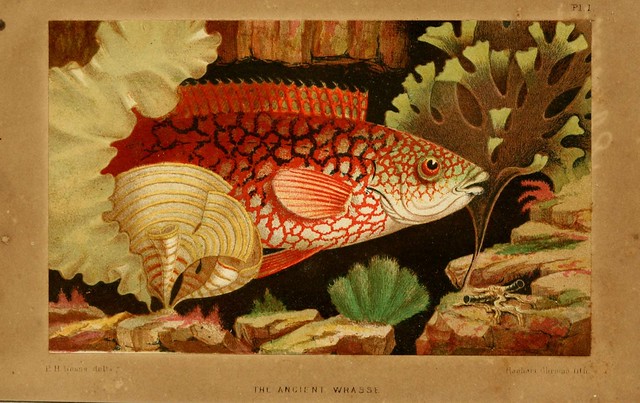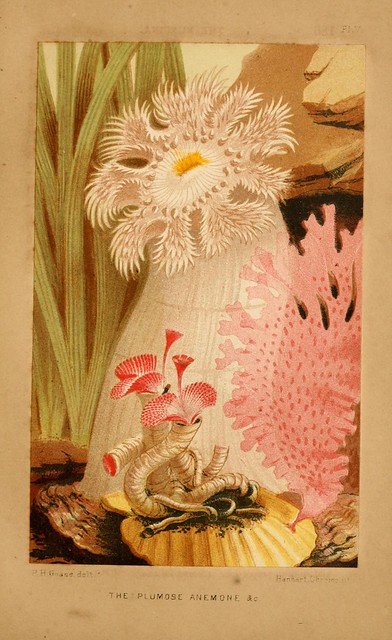 |
Photo Flickr - n5_w1150 (cc) |
The many ancient drawings, carvings, and pictures of aquariums from places in antiquity like Eqypt and Sumeria show us that these past peoples knew the beauty of the tanks and they also desired to maintain that beauty and pass on the secrets of these creatures. The ancient Romans were also known to have traded live fish as commodities in their agoras (markets).
Goldfish and Koi fish
In another part of the world, the art of selective breeding began in China around 2,000 years ago. They had been known to produce the now-famous goldfish developed from the regular carp. By the 18th century, goldfish as an ornamental fish was common in Europe and later became popular in America.
developed from the regular carp. By the 18th century, goldfish as an ornamental fish was common in Europe and later became popular in America.
Cultured live koi – that familiar fish with the red, white and black coloration, was already a commercial item in the old trade routes that spanned China, Japan, and Europe around the 16th century. Later, its reputation also grew and became very popular. Much later, it was also exported to Europe and America.
Crude Beginnings
In the early 19th century, aquarium-keeping began. England, Germany, and France all vied to top themselves in mounting exhibits of public aquariums. It did not get a good reception as many were appalled by it.
At that time, there was very poor understanding yet on the various roles of water chemistry, the nitrogen cycle, filtration, and aeration. The size of the tanks was also limited by the holding power of the construction materials then.
The First Aquarium
In 1850, a Mr. Harrington declared through a paper he wrote for the Chemical Society of London that he had successfully maintained a stable aquarium. Fish-keeping suddenly became a popular hobby.
Three years after, many Zoo’s and farms began to open the first public aquariums one after another when they noticed a good turnout. Soon, public aquaria were all over the major European cities patronized by eager but intrigued visitors.
Household Items
It was not long after when the aquarium became a fashionable household item in Victorian England. Curiously, there were no tanks for sale then, although there were various books and other how-to manuals already available for constructing aquariums.
The first constructed tanks leaned more to the ornamental side rather than being functional at best. Most early designs featured a glass front and three wooden sides (They were sometimes constructed from slate). They were coated in pitch to make them watertight.
Tank Basics
Soon, these construction problems were overcome little by little. There was a real breakthrough with the development of silicone sealants.
It became possible now to manufacture an all-glass aquarium in all sizes and shapes. Bulky steel frames became obsolete and tanks can now be moved without the danger of breaking the seal.
Understanding Technology
At around this time, a better understanding of the needs of the tank’s fish inhabitants led to the invention of the heater and the thermostat, as postulated by a Mr. Humphreys. In maintaining fish, this person would be the one to mention the significance of the tanks chemistry toward the safety of the fish.
With a deeper understanding of water chemistry and other related matters, filtration and lighting were soon recognized as additional important elements to the total upkeep of the fish in the aquarium.
The Modern Aquarium
Today’s modern aquariums are made mostly of glass. Nowadays, more tanks are being made from acrylic instead of glass because it doesn’t break as easily. This is because acrylic is pliable and can be used to manufacture unusual shapes. (Acrylic aquariums are mostly used in big showrooms in business and office buildings today.)
are made mostly of glass. Nowadays, more tanks are being made from acrylic instead of glass because it doesn’t break as easily. This is because acrylic is pliable and can be used to manufacture unusual shapes. (Acrylic aquariums are mostly used in big showrooms in business and office buildings today.)
Nowadays, aquaria made of acrylics are regarded as the lightweight alternatives to those made of glass. This is especially true now that manufacturers had produced harder and scratch-resistant plastics. Perhaps, they would replace the unwieldy glass in the future.
Improved Technology
Also, there had been such long strides made in the improvement of the accompanying technology related to aquarium keeping: heating, lighting, filtration, and aeration among others.
Apart from the technology, there is now a better understanding of marine life and ecology that pushed the hobby into what it is today. Taking together both marine and freshwater aquarium varieties, the simple hobby of keeping a living fish in a bowl had become the world’s 2nd most popular hobby. (Gardening is number one.)
The Future Of The Aquarium
There is now a growing number of fish varieties available for keeping in aquariums and the size and shape of aquarium tanks have evolved, too.
However, according to experts, the future of the hobby is still focused on the next advances in water purification, nutrition, lighting and other related matters. Fish breeding is an old and popular practice that has become quite popular around the world with good breeds being created constantly. (Genetic manipulation is still frowned upon.)
Whatever direction the hobby is moving into, today’s hobbyists are reminded that they are part of a thousand-year-old freshwater aquarium history as they tinker their aquariums and feed their aquatic pets.
as they tinker their aquariums and feed their aquatic pets.
| By Bob Finklea - Article Source: EzineArticles |

